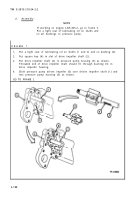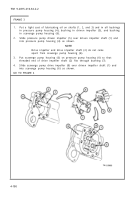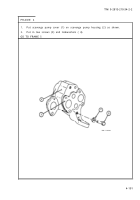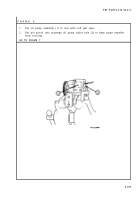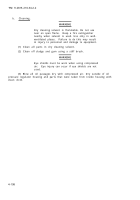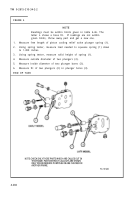TM-9-2815-210-34-2-2 - Page 215 of 968
TM 9-2815-210-34-2-2
(d) Slowly close restrictor valve while watching pressure gage and
pressure relief valve hole in pump.
Check that oil starts to squirt out of pressure
relief valve hole when pressure gage reads between 140 and 225 pounds per square
inch.
(e) If oil does not start to squirt out of pressure relief valve hole when
pressure gage reads between 140 and 225 psi, stop test. Take apart pressure relief
valve. Refer to para 4-17a, frame 4.
Add or take out shims shown in figure 4-3 to
change relief valve opening pressure. Do steps (c) and (d) again.
Figure 4-3.
Pressure Relief Valve Shims.
(2) Flow test.
NOTE
Pressure relief adjustment must be done before
flow test.
Refer to para 4-17e (1).
Oil pump has two halves. Front half of pump
behind drive shaft is called pressure pump.
Rear half of pump is called scavenge pump.
(a) If scavenge pump has not already been oiled, pour some engine
lubricating oil into scavenge pump so scavenge pump impellers will not be damaged
during test.
(b) Hook oil pump to test bench as shown in figure 4-2.
(c) Open pressure restrictor valve. Start drive unit, Run pump until
air is out of system and oil temperature holds steady at 200°F to 210°F for all engines
except LDS-465-2 and 220°F to 240°F for engine LDS-465-2.
(d) Work drive unit to speed up oil pump to 3,420 rpm. Slowly close
restrictor valve until pressure gage reads 110 psi.
(e) For all engines except LDS-465-2, check that flow meter reads
22 gallons per minute (gpm) or more.
If flow meter reads less than 22 gpm, get a
new oil pump.
(f) For engine LDS-465-2, check that flow meter reads 26 gpm or more.
If flow meter reads less than 26 gpm, get a new oil pump.
4-196
Back to Top



